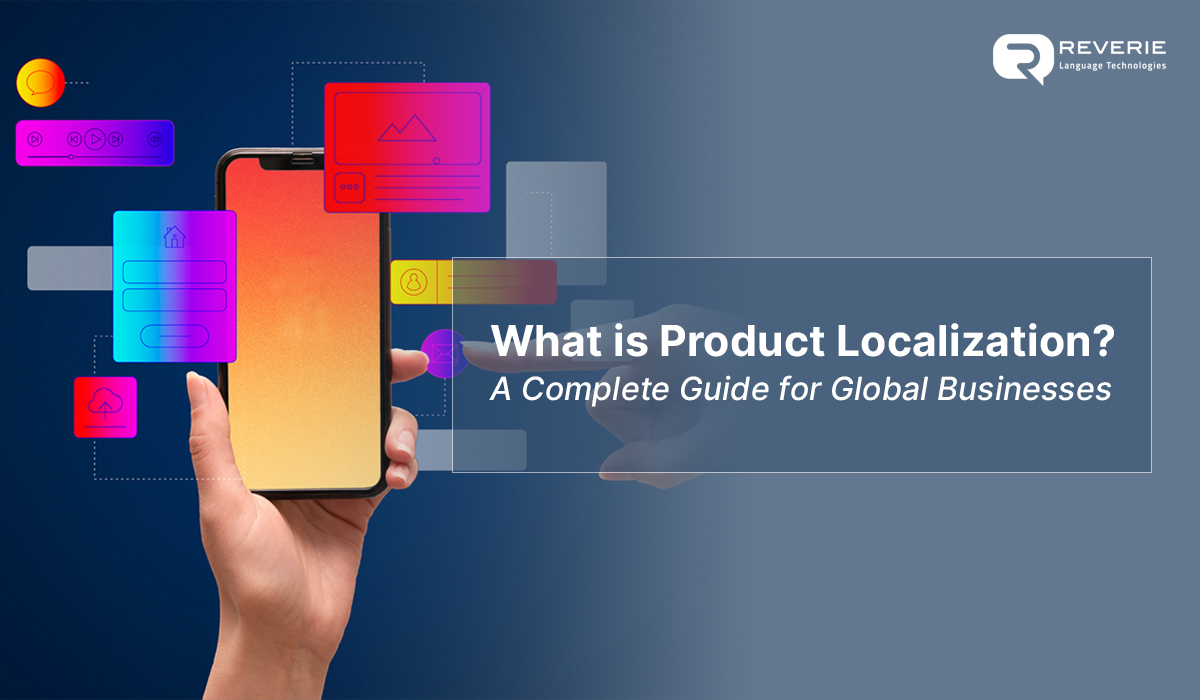Product localisation goes beyond translation. It involves adapting visuals, currencies, date formats, legal requirements, and user experiences to make a product feel native. A brand’s global success depends on more than just launching in multiple countries. Companies that fail to tailor their products to local languages, cultures, and consumer expectations risk losing market share.
Research by CSA shows that 76% of consumers prefer products with information in their native language. Netflix, Airbnb, and McDonald’s have mastered this with localisation—customising their platforms, content, and services to fit diverse markets. A well-executed localisation strategy increases customer trust, drives engagement, and opens new revenue streams. Here’s how businesses can leverage product localisation to expand globally without friction.
Product Localisation vs. Translation—What You’re Probably Getting Wrong
Many businesses assume translating their content is enough to expand globally. However, translation alone doesn’t address cultural context, market preferences, or regulatory differences. The same CSA report found that 40% of consumers won’t buy from websites in a language they don’t understand, but effective product localisation requires more than just language adaptation.
Translation converts words from one language to another, but product localisation ensures the entire product experience feels natural to users in a specific region. This includes modifying UI elements, currency formats, product descriptions, images, and even colors to suit cultural norms.
For example, Airbnb doesn’t just translate its platform—it adjusts booking preferences, pricing displays, and customer support for each country.
Localisation also extends to regulations. Financial services, healthcare apps, and e-commerce platforms must comply with local laws, such as GDPR in Europe, CCPA in California, and the Personal Data Protection Bill in India. A simple translation won’t align a product with regional compliance standards. Companies that overlook these nuances often struggle to gain traction in new markets.
How Product Localisation Unlocks New Revenue Streams
Expanding into international markets presents massive revenue opportunities, but without product localisation, businesses face adoption barriers. In fact, localised apps see 128% more downloads and 26% higher revenue per user, proving that localisation directly impacts bottom-line performance.
What is Product Localisation?
Product localisation is the process of adapting a product’s content, design, functionality, and communication to meet the linguistic, cultural, technical, and legal requirements of a specific target market.
Importance of Product Localisation
The goal of product localization is to give the impression that the product was designed specifically for the target market. A well-localised product creates instant familiarity and relevance, which significantly boosts user adoption and brand affinity. When users interact with a product in their own language, see culturally familiar content, and enjoy seamless usability that reflects their preferences, they are more likely to convert and stay loyal.
Global brands that lead in localisation have demonstrated their strategic value, such as: Netflix’s investment in multi-language subtitles and dubbing, McDonald’s region-specific menus, and Slack’s contextual language support have all contributed to global market dominance.
Localisation also strengthens customer retention. Consumers feel a stronger connection with brands that cater to their preferences, leading to higher engagement and lifetime value. Companies that successfully localise their products increase their chances of outperforming competitors in linguistically diverse markets.
The Product Localisation Playbook: Key Elements for Seamless Global Integration
A poorly localised product feels foreign to its audience, reducing engagement and trust. Businesses need a structured approach to localisation that aligns with user expectations. Below are key elements to ensure seamless global integration.
- Linguistic Localisation: Speaking the Language of Your Customers
Accurate translations are essential, but they must reflect local expressions, tone, and intent. Direct translations often lead to misinterpretations that can harm brand perception.
- Businesses should use professional linguists, AI-powered translation tools of Reverie, and translation memory systems to ensure consistency and contextual accuracy.
- Glossaries and style guides help maintain brand voice across multiple languages while avoiding errors that could alienate users.
- Example: KFC’s slogan “Finger Lickin’ Good” was mistranslated in China as “Eat Your Fingers Off,” damaging its early brand image.
- The Role of Cultural Localisation: Adapting Beyond Words
A brand’s success in a new market depends on how well it aligns with cultural values, traditions, and consumer behaviour.
- Colors, symbols, and images can have different meanings across cultures.
- Marketing campaigns, product packaging, and user experiences must be tailored to avoid cultural insensitivity.
- Example: In India, red symbolises marriage and prosperity, while in South Africa, it represents mourning.
- Technical Localisation: UI/UX That Feels Native
A seamless user experience requires adapting technical elements to local preferences.
- Navigation, date/time formats, and payment options should match user habits.
- Localisation must extend to mobile and desktop interfaces to ensure a cohesive experience.
- Example: Right-to-left languages like Arabic require mirrored UI layouts, while Japanese users prefer vertical text formatting.
- Regulatory & Legal Localisation: Compliance Matters
Legal requirements vary across regions, and failing to comply can lead to financial and reputational damage.
- Companies must adhere to GDPR (Europe), CCPA (California), and the Personal Data Protection Bill (India) when handling user data.
- Some countries have strict rules on marketing messages, claims, and endorsements.
- Ensuring compliance with local regulations builds consumer trust and minimises legal risks.
Example: Google faced a ₹136 crore fine in India for violating local competition laws.
Steps to Implementing a Winning Product Localisation Strategy
A structured localisation strategy reduces market entry risks and improves user adoption. Below are the essential steps to execute a successful localisation plan.
- Market Research & Audience Insights:
- Identify the target audience’s language, buying behaviour, and expectations.
- Conduct competitor analysis to understand localisation benchmarks.
- Leverage tools like Google Market Finder, and local focus groups to gather insights.
- Build a Localisation Team:
- Assemble linguists, UX designers, project managers, and legal experts for an end-to-end localisation process.
- AI-powered localisation tools like Anuvadak can streamline content adaptation.
- Choose the Right Localisation Tools:
- Use Translation Management Systems (TMS) to automate and streamline multilingual content.
- AI-driven platforms improve translation accuracy, reduce manual work, and accelerate time-to-market.
- Implement Internationalisation (i18n):
- Develop products with a flexible code structure to support multiple languages and regional settings.
- Ensure that UI elements like date formats, currency symbols, and character encoding are adaptable.
- Execute Localisation & Testing:
- Functional testing, linguistic testing, and UI/UX validation are essential for quality assurance.
- Each localised element must be evaluated to ensure consistency, clarity, and cultural relevance across markets.
- Example: HSBC had to overhaul its global “Assume Nothing” campaign after it was mistranslated as “Do Nothing” in several countries, leading to brand misinterpretation and costly rebranding.
- Launch, Measure, and Optimise:
- Monitor localisation performance using heatmaps, A/B testing, and engagement analytics.
- Gather real-time feedback to refine user experiences.
Powering Seamless Product Localisation
Global success depends on delivering a product that resonates with diverse audiences. Effective localisation ensures that language, design, compliance, and user experience align with local expectations. Companies that invest in localisation gain higher engagement, stronger customer loyalty, and increased revenue.
Reverie’s Anuvadak simplifies the process, reducing manual workload by 90%. The platform provides seamless website and content localisation, while App Localisation services enhance mobile experiences for multilingual users.
Your product deserves a global audience—but without the right localisation strategy, your growth potential is limited. With AI-powered localisation, culturally adaptive content, and seamless UI/UX integrations, you can break through language barriers and establish a strong presence in international markets. Book a free demo and strategise your localisation strategy today.
Faqs
What exactly does product localisation involve?
Product localisation is the process of adapting a product’s content, interface, functionality, and compliance frameworks to align with the language, culture, and expectations of a specific market.
Can localisation impact brand perception?
Yes, inaccurate or culturally tone-deaf localisation can erode brand credibility quickly. Thoughtful localisation, on the other hand, enhances brand authenticity and relevance, helping businesses build trust in new markets.
Which parts of a product are usually localised?
Beyond language, localisation typically includes UI layout, payment methods, date/time formats, address fields, and onboarding flows—ensuring the product feels native to each market.
What’s the role of AI in modern localisation workflows?
AI is increasingly critical for speed and scale. It powers real-time translation suggestions, consistency checks, and automated content deployment—especially for businesses handling high-volume multilingual content. Reverie’s Anuvadak uses AI to reduce manual effort and speed up rollout without compromising quality.
Is India a unique challenge for localisation compared to other markets?
Yes, India’s localisation landscape is complex due to its 22 official languages. Succeeding here demands both linguistic depth and cultural intelligence—something Reverie is purpose-built to handle, with native-language capabilities and compliance-ready solutions.


